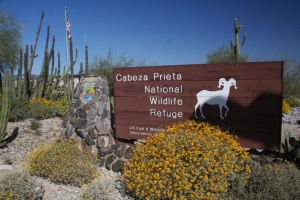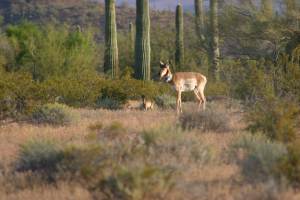by Ken Shroyer
The Cabeza Prieta National Wildlife Refuge, located in southwest Arizona, is the third largest wildlife refuge in the lower forty-eight states with 860,010 total acres. Cabeza Prieta is Spanish for “dark head,” referring to a lava-topped granite peak within a remote mountain range in the western corner of the refuge.[1] Most of the refuge consists of wide,  flat desert valleys, separated by narrow volcanic mountain ranges running north to south. Being in the heart of the Sonoran desert, the refuge may see temperatures top 100 degrees Fahrenheit for ninety to one hundred consecutive days from June to October. On occasion temperatures can exceed 115 degrees Fahrenheit.[2]
flat desert valleys, separated by narrow volcanic mountain ranges running north to south. Being in the heart of the Sonoran desert, the refuge may see temperatures top 100 degrees Fahrenheit for ninety to one hundred consecutive days from June to October. On occasion temperatures can exceed 115 degrees Fahrenheit.[2]
Partially in response to public demand generated by the Boy Scouts of America, Arizona Game Protective Association, and the Audubon Society, this wildlife refuge was originally established as a “Game Range” by Executive Order 8038 signed by President Franklin D. Roosevelt on January 25, 1939, in order to assist in the recovery of the desert bighorn sheep.[3] On March 21, 1975, the original executive order was amended; giving sole jurisdiction of the “Game Range” to the U.S. Fish and Wildlife Service and the area renamed Cabeza Prieta National Wildlife Refuge.
While this refuge is a desert ecosystem, the patterns of rainfall during the winter and summer months stimulate the growth of more plant species than in many other desert ecosystems. Cabeza Prieta National wildlife Refuge is home to over four hundred varieties of plant life, including the giant saguaro, cholla, and ocotillo cacti, along with mesquite and creosote bush. [4]
It also hosts over three hundred animal species that have found a way to exist in such a  harsh climate. While the refuge was created to protect big horn sheep, the endangered Sonoran pronghorn antelope is probably the refuge’s most famous of inhabitant. There are only an estimated one hundred fifty of the Sonoran pronghorns left in the area. The park has limited access from March 15 to July 15 for the fawning season in an effort to increase their numbers.
harsh climate. While the refuge was created to protect big horn sheep, the endangered Sonoran pronghorn antelope is probably the refuge’s most famous of inhabitant. There are only an estimated one hundred fifty of the Sonoran pronghorns left in the area. The park has limited access from March 15 to July 15 for the fawning season in an effort to increase their numbers.
In an attempt to keep the refuge as pristine as possible, vehicle traffic is confined to designate roads only, with parking up to fifty feet from the center of a road as long as that area has been previously used for parking.[5] To visit the park, one needs to first go to the visitor’s center and obtain a valid Refuge Entry Permit. In addition, because of the proximity of the refuge to the Barry M. Goldwater Air Force Range, a Military Hold Harmless Agreement must be signed. This agreement states that if you should run across a military shell of any kind you will leave it alone, note its location, and report it to the refuge staff.
Further Reading
The U.S. Fish and Wildlife Service official site: http://www.fws.gov/southwest/refuges/arizona/cabeza/index.html.
Sangres.com also provides a nice website: http://www.sangres.com/arizona/wildlife-refuges/cabezaprieta.htm.Sangres.com.
[1] U.S. Fish & Wildlife Service. “Cabeza Prieta National Wildlife Refuge.” U.S. Fish & Wildlife Service. http://www.fws.gov/southwest/refuges/arizona/cabeza/index.html (accessed March 26, 2012).
[2] Wildlife Viewing Areas. “Cabeza Prieta National Wildlife Refuge.” Watchable Wildlife, Inc. http://www.wildlifeviewingareas.com/wv-app/ParkDetail.aspx?ParkID=212 (accessed March 27, 2012).
[3] U.S. Fish & Wildlife Service. Cabeza Prieta National Wildlife Refuge, Comprehensive Conservation Plan,Wilderness Stewardship Plan and Environmental Impact Statement August 2006. Albuquerque, New Mexico: Division of Planning, National Wildlife Refuge System, Southwest Region, 2006.
[4] The American Southwest. “Cabeza Prieta National Wildlife Refuge.” The American Southwest. http://www.americansouthwest.net/arizona/cabeza-prieta/national-wildlife-refuge.html. (accessed March 27, 2012).
[5] Sangres.com.” Cabeza Prieta National Wildlife Refuge.” Sangres.com. http://www.sangres.com/arizona/wildlife-refuges/cabezaprieta.htm.Sangres.com. (accessed March 26, 2012).
